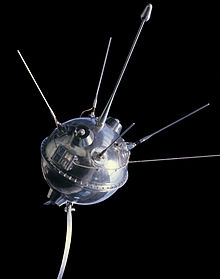
Back མིའི་རིགས་ཀྱིས་ཟླ་བའི་གོ་ལར་དཔྱད་ཞིབ་བྱེད་པའི་དོན་ཆེན་ཟིན་ཐོ། Tibetan Llista de missions d'exploració de la Lluna Catalan Chronologie der Mondmissionen German Anexo:Misiones espaciales lanzadas a la Luna Spanish فهرست ماموریتها به ماه Persian Kuun valloituksen aikajana Finnish Lista de misións á Lúa Galician चंद्रमा के मिशन की सूची Hindi Listo pri misioni a la Luno IO 月探査ミッションの一覧 Japanese


Missions to the Moon have been numerous and one of the earliest space missions, conducting exploration of the Moon since 1959.
The first partially successful lunar mission was Luna 1 (January 1959), the first probe leaving Earth and flying past another astronomical body. Soon after that the first Moon landing and the first landing on any extraterrestrial body was performed by Luna 2,[1] intentionally impacting the Moon on 14 September 1959. The far side of the Moon, which is always facing away from Earth due to tidal locking, was seen for the first time by Luna 3 in (7 October 1959). In 1966, Luna 9 became the first spacecraft to achieve a controlled soft landing,[2] while Luna 10 became the first mission to enter orbit, and in 1968 Zond 5 became the first mission to carry terrestrial lifeforms (tortoises) to close proximity of the Moon through a circumlunar approach.[3]
The first crewed missions to the Moon were pursued by Soviet Union and the United States, becoming the climax of the Space Race. While the Soviet Union shifted to robotic sample return missions, the American Apollo program proceeded successfully, with Apollo 8 becoming the first crewed mission to enter lunar orbit in December 1968. On 20 July 1969 Apollo 11 landed on the Moon, during which Neil Armstrong became the first person to walk on the Moon. At the same time another mission, the robotic sample return mission Luna 15 by the Soviet Union had been in orbit around the Moon, becoming together with Apollo 11 the first ever case of two extraterrestrial missions being conducted at the same time. Until 1972 crewed Apollo missions and until 1976 Soviet uncrewed sample return missions, with the first ever successful extraterrestrial rovers (Lunokhod programme), continued. After that no dedicated lunar mission were conducted until 1990. Since then the following nations and organisations (in chronological order) have visited the Moon, after the Soviet Union and the United States: Japan, the European Space Agency, China, India, Luxembourg, Israel, Italy, South Korea, the United Arab Emirates, Russia, Mexico, and Pakistan. In 2018 the far side of the Moon was for the first time landed on by the Chang'e 4 mission at the South Pole–Aitken basin on 3 January 2019 and deployed the Yutu-2 rover. Five years later, China followed with Chang'e 6 sample return mission to the far side whose lander successfully landed in Apollo crater on 1 June 2024 and collected lunar samples.
The Moon has also been visited by five spacecraft not dedicated to studying it; four of these spacecraft have flown past for the purpose of gravity assistance, and a radio telescope, Explorer 49, was placed into selenocentric orbit in order to use the Moon to block interference from terrestrial radio sources.
- ^ "Why failure is the fuel for a trip to Moon". The Times of India. 11 September 2019. Archived from the original on 19 February 2021. Retrieved 11 September 2019.
- ^ "Chandrayaan-2 landing: 40% lunar missions in last 60 years failed, finds Nasa report". Archived from the original on 8 September 2019. Retrieved 28 June 2022.
- ^ Cite error: The named reference
:3was invoked but never defined (see the help page).
© MMXXIII Rich X Search. We shall prevail. All rights reserved. Rich X Search